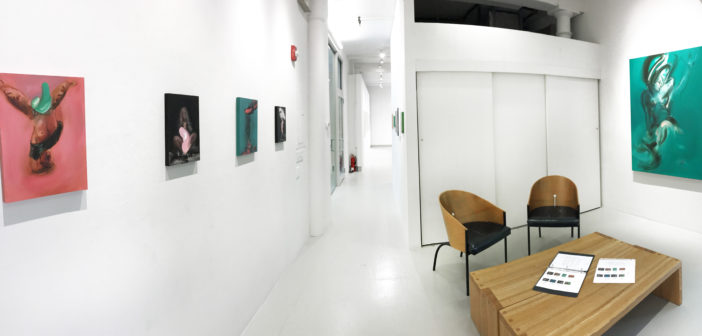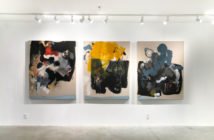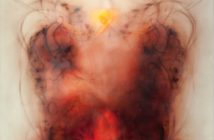This September, painter Ariel Basson Frieberg fearlessly explores figure painting through two striking gallery shows: Ariel Basson Freiberg: Trespass Daughter at Howard Yezerski Gallery (September 8–October 10), and Reconfigure with fellow Boston-based painter Lavaughan Jenkins at Abigail Ogilvy Gallery (September 1–October 1). While Freiberg holds her own very well in the solo show, her works’ dialogue with Jenkins’ is a truly memorable exhibition that offers two daring directions for figure painting. Freiberg’s paintings—in both shows from her recent series Trespass Daughter— are lurid explosions of teal, black, red and pink. As gallerist Howard Yezerski, who has shown her work before, points out, Trespass Daughter takes a bold leap past her work from just a few years ago, which was meticulously painted to resemble collage. In those paintings, color would tear away like paper to reveal closed eyes, a fragment of an embrace, or parted lips. In Trespass Daughter, Freiberg eschews the mechanics of collage. Her work has never been prudish, but now sensuality is no longer mediated by trompe-l’oeil tricks.
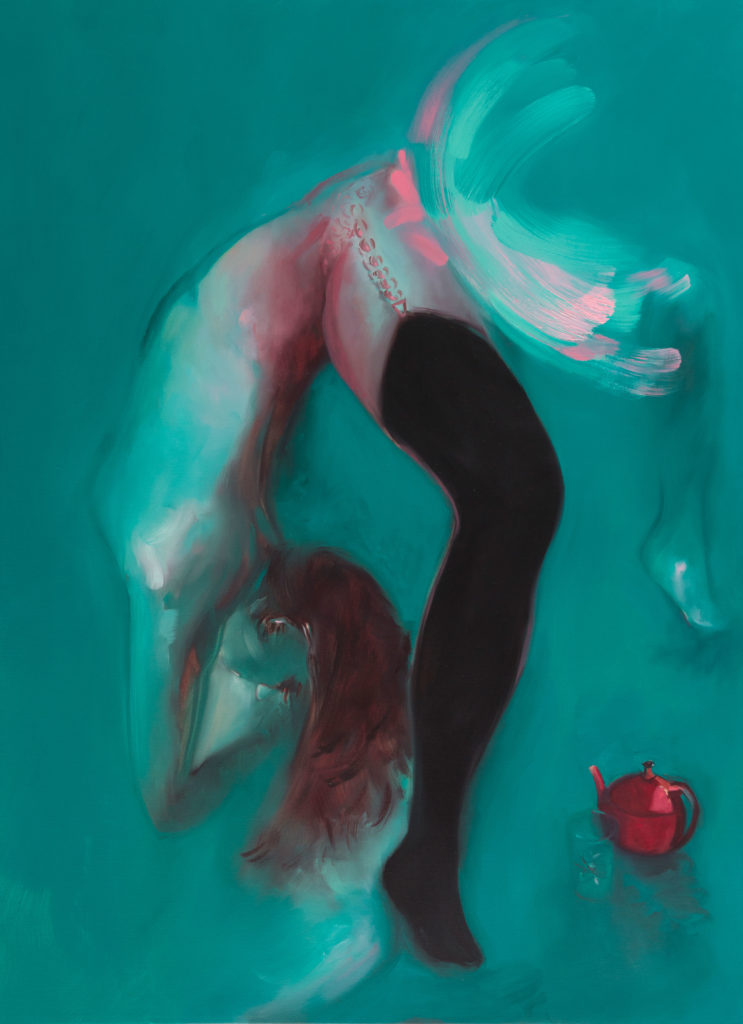
Ariel Basson Freiberg, Kerosene, Oil on linen, 48 x 36". Courtesy of Abigail Ogilvy Gallery.
With the exception of several enigmatic portraits like Eclipse or Soul Says at Abigail Ogilvy, poses range from titillating to overtly sexual. Scantily clad female figures contort amidst high-energy strokes of pink or phthalo green paint that emphasize points of contact (real or desired). In other works, various female body parts protrude from inky black backgrounds like neon signs at night. Some of the smaller works are cartoonish, but even they have the power to grab the viewer’s immediate attention.
Most of Freiberg’s small studies appear at Howard Yezerski Gallery, tucked away from the windows in an intimate, secondary space that emphasizes their transgressive appeal. Yet Trespass Daughter does not suggest a simple peep show. The woman in Wear might rest face down and dangle a lace thong from raised feet, but a bold sweep of hot pink between her legs playfully refuses to let us go any further, returning attention from her body to her gesture of removal even as we dwell on the bright color. In Carmilla at Abigail Ogilvy, one of the few paintings that contains multiple figures, the flurry of pink into which the figures dissolve where they meet celebrates their intimacy while also obscuring it. Action translates into abstraction in such a way that these strokes of color are simultaneously fig leaves and magnifying glasses.
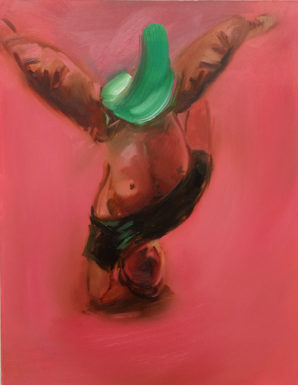
Ariel Basson Freiberg, Sizzler, 2017, oil on panel, 14 x 11". Courtesy of Howard Yezerski Gallery.
Freiberg wields the force of a female artist rebelling against that famous “male gaze.” She does not eliminate it, but she does control the act of display. This is evident in Sizzler, where Freiberg co-opts breakdancing, a traditionally male form of self-expression. A man is depicted, but it is her gesture—her dash of thick, erect green paint—that sexualizes the pose. In a show of feminist wit, Leg Up While the Cactus Watches substitutes a wholly different kind of voyeuristic “prick.”
Freiberg is also unabashedly contemporary, drawing inspiration from personal observations of modern consumerism. When her figures choose to wear clothes, they sport stiletto heels, sneakers, tight jeans or lace panties paired with black tights and garter belts. Their attire unites the bedroom, the club, and the right to sexual self-expression. These scenes are part Robert Mapplethorpe, part Nicki Minaj. They make no apologies.
Which such audacity in Freiberg’s approach to the figure, her pairing with Lavaughan Jenkins in Reconfigure at Abigail Ogilvy seems incongruous at first. Jenkins’s figures are reserved. Standing or kneeling, they take on an archaic humility that is at once powerful and somewhat forlorn. They seem to wait silently and patiently for someone to return their round-eyed gaze. His palette of black, white, soft pastels and earth tones is inspired by Goya. There is nothing of Freiberg’s modernity, and certainly nothing of her neon-nights verve. Yet in fact this pairing was Freiberg’s express desire, as Ogilvy explained.
To the uninitiated, Jenkins’ works are sculptures, foot-high figurines that stand or kneel on small turntable platforms that allow a 360-degree view of the form. Jenkins, however, insists that these are paintings. They are, after all, mostly oil paint—luscious layers applied with a palette knife or straight from a tube onto the armature/canvas. The works on display now, in September, were completed in the spring to allow for drying time.
As in Freiberg’s work, there are paradoxical tensions within the act of interpreting these figures that enrich the viewing experience. Their protruding snouts and monocular eyes suggest they are non-human, but Jenkins describes those white bulges that appear at each figure’s midriff as a “memory doctor’s apron”—a reference to Nicole Krauss’ 2002 book Man Walks Into a Room. According to Ogilvy, Jenkins prefers to leave interpretations of his work open to the viewer, yet he admits that each figure is intensely specific. Each is a memory-driven homage to someone from the artist’s personal life.
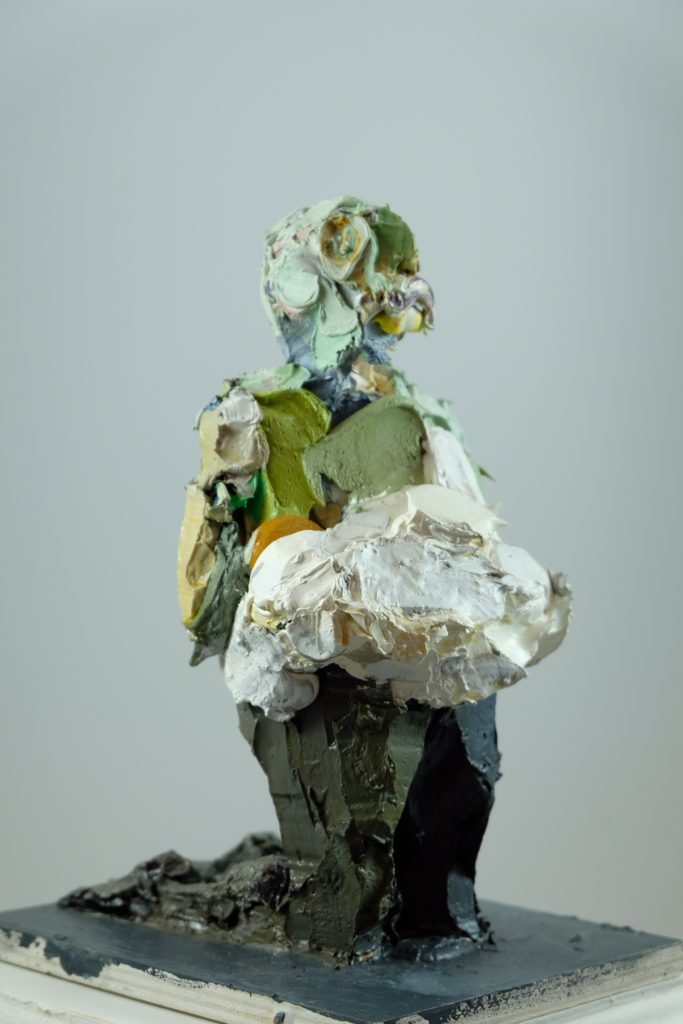
Lavaughan Jenkins, Untitled 11, Oil paint, and modeling paste with a wire and plaster armature, 10 x 6 x 5". Courtesy of Abigail Ogilvy Gallery.
Freiberg’s gestural mark-making magnifies her figures’ sexuality while abstracting their actions. Jenkin’s hides his portraits beneath the very layer of paint that create them. Here is the kernel of a connection that is revelatory to both artists’ current navigation of painting as it relates to subject. The figure is supremely important to Freiberg and Jenkins. Yet for both artists, the idea of portraiture never takes over the idea of painting. Instead, painting the human form is about conveying a creative stance, whether it be celebrating sexual “trespass” or exploring the accrual of memory. With each raw gesture, Freiberg and Jenkins reaffirm the visceral power of that lies in paint.

